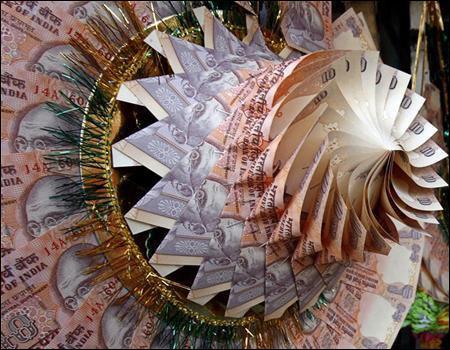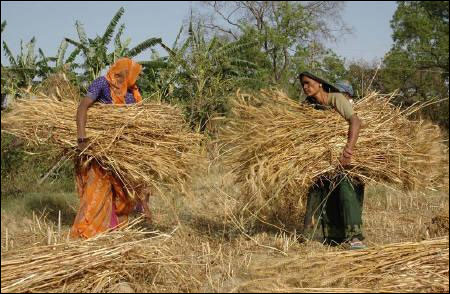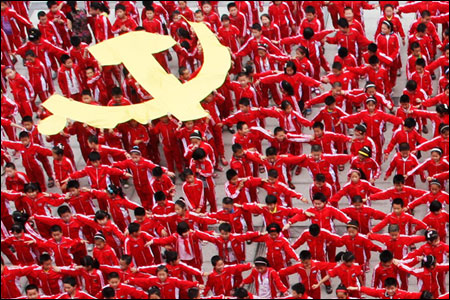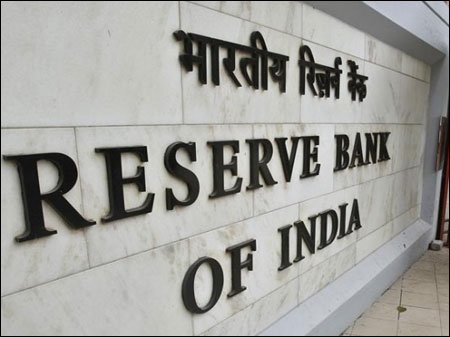Photographs: Reuters Sonali Ranade
A US dollar fetched approximately Rs 44 at the end of May 2011, and closed at Rs 54.42 last Friday. Over the course of the last 12 months, the dollar has appreciated by approximately 21.5 per cent. In the first blush of reforms in 1990, the rupee was devalued by 20 pc over a period of 10 days. Is the rupee now fairly valued? Can it fall more? Should it fall more?
In a system of market-determined rates, the forces of demand and supply decide these things. However, we have never had a free market in foreign exchange and the external value of the rupee was always set by administrative fiat backed up by an elaborate system of exchange controls.
A part of these controls were dismantled in 1990 with reforms. The rupee has never been convertible on capital account. The Reserve Bank of India still has a variety of controls on who may buy foreign exchange and for what purpose in the market.
Apart from direct intervention, the RBI has a variety of other levers with which to guide the external value of the rupee. Therefore, it effectively sets a fairly defined range in which the dollar trades in the foreign exchange market. A free market in the $-INR is largely a myth. Therefore, the correct question to ask is, where should the INR really be and to what purpose.
The exchange rate policy in India was designed in the '50s to achieve certain goals of development and hasn't changed all that much even after reforms. It is worth considering the logic behind the foreign exchange policy.
Click on NEXT for more...
How does the external value of the rupee matter?
Prime Minister Jawaharlal Nehru borrowed the Stalinist model of economic growth almost lock, stock and barrel from Russia after being greatly impressed by the rapid strides that Stalin had made in industrializing the Soviet Union. This model in essence called for massive transfer of income and wealth from agriculture into industry and developing the same using technologies developed in Western Europe.
The model was successful in the USSR because prior to communists, the elites had deliberately herded common people onto unproductive farms under crippling taxes, prevented mechanisation of agriculture and fought to keep industrialisation at bay in Russia in order to prevent concentration of peasants in urban centres that could lead to a revolt against the feudal elites.
Stalin was able to reverse these processes. Mechanisation of agriculture led to a huge jump in agriculture productivity and wealth. Stalin was able to tax this newly created wealth through a variety of controls and channelise the same into industrialisation using Western technology.
Industrialisation created a huge demand for labour that was met by moving people out of farms into factories via a State schooling system. In the initial phases, for close to 30 years, the Stalinist model created humongous wealth and prosperity for Russia. It began to run into problems only when it failed to innovate on its own and was stifled by multiple market failures.
Click on NEXT for more...
How does the external value of the rupee matter?
Nehru attempted the same in India with Russian help. Massive dams were to be built to step up agricultural productivity through irrigation. The wealth created in agriculture was then to be used to invest in modern industry.
And over time, the labour and people would be moved from agriculture to industry through a State schooling system. As in Russia, the model worked for some time in India, though not as well as in the USSR.
India was able to step up its GDP growth from something less than 0.5% pa to something over 4.5% in the two decades of '50s and '60s.
As in the USSR so in India, the model ran out of steam once the initial wealth created by agriculture had been sunk in industry but yielded no further returns due to stifling price and other controls. In fact, since India did not mechanise agriculture as Stalin did, nor did it nationalise land into collectives, the spurt in wealth created by agriculture in the first two decades came primarily from investment in dams and irrigation.
This model of growth is so deeply embedded in our collective psyche that few think beyond it. For most of us, even today, it is the only way to growth and development.
Click on NEXT for more...
How does the external value of the rupee matter?
Photographs: Reuters
How did India collect the wealth from farmers to invest in Industry? One should pause to think about this because we have never formally taxed farmers and still do not do so. How was surplus generated in agriculture transferred to industry?
The answer lies in price controls. We do not tax farmers but we take away any surplus they generate by paying them far below market for their produce. Export controls on agricultural products in tandem with exchange controls lie at the heart of this mechanism for surreptitiously transferring wealth created by farmers to industry.
I have detailed how this works elsewhere. For the nonce, note the effect of an overvalued INR. Farmers cannot export their produce directly, or even through traders in case of food crops.
Instead, the stuff they produce like cotton, tea, sugarcane, rubber etc is channelised to industry and the right thing to do, as per conventional thinking, is to keep these inputs as cheap as possible, since industry "adds value" before exporting them.
That is true but where does this value go? It doesn't flow back to farmers in any case. But farmers pay for all that they use for production or consumption at prices determined by markets rate for the dollar.
Why have other strong nations fought long and hard to keep their currency undervalued in relation to others? The answer is simple. Nations wish to maximise job creation in the domestic economy and export whatever their domestic economy produces cost-effectively. Maximisation of job creation is an explicit policy goal of the exchange rate policy.
Click on NEXT for more...
How does the external value of the rupee matter?
Photographs: Reuters
In India, on the other hand, we are in love with a strong rupee and pay scant attention to job creation. That was because our imports, ignoring gold, are largely petroleum and capital goods, which are price inelastic, while our exports, besides agricultural commodities like tea, cotton, jute, sugar etc are an ill-defined basket of goods whose price elasticity is indeterminate.
Since we are a net importer, conventional wisdom dictates that we keep the INR overvalued in our favour. That policy also favours both our industry and our middle class who are the main consumers of imported products while it further "taxes" our farmers who are net earners of foreign exchange.
The situation has changed somewhat with software and services exports where the external value of the INR directly impacts job creation for the middle class, creating some awareness among them of how the dynamics of INR pricing works but not nearly enough.
A further factor that closed the minds of our policy-makers in the past to use of agricultural exports for domestic job creation and growth was the closed nature of export markets for agricultural produce in the EU and other developed countries. Import quotas, subsidies to local farmers in these countries and a variety of other trade barriers shut Indian farmers out of these markets.
That has changed with shifting demographics in these countries and the emergence of China as the world's largest importer of food and other agricultural commodities. This development has barely registered in Indian policy circles and intelligentsia despite the fact that it can completely change the game for Indian farm exports.
Click on NEXT for more..
How does the external value of the rupee matter?
Photographs: Reuters
China is the world's largest importer of soya, corn, and increasingly other cereals, dwarfing total consumption in other countries as its middle class grows. India needs to focus on China as an export market for its farmers and we must begin creating the mechanisms necessary to facilitate opening up the Chinese markets for our farmers.
Tapping the Chinese market cannot be left to markets alone. Think tea, rubber, soya, jute. Recall the huge role the State had to play in creating trading markets for these products, setting up of price discovery mechanisms, transportation and warehousing linkages, ports, export houses and the like.
This is not asking for subsidy or State intervention in price discovery but for creation of the institutional mechanisms whereby trade is facilitated.
What was done in respect of tea or rubber or soya needs to be replicated across things like corn, rice, wheat etc. The State has to play its role in facilitation of trade, which it isn't doing at the moment. The whole policy orientation towards agriculture and export markets for its produce needs to be rethought and revised top to bottom.
Click on NEXT for more...
How does the external value of the rupee matter?
Photographs: Reuters
The RBI can afford to let the market play a greater role in determination of the external value of INR for a while without undue panic or worry. India is fundamentally a viable economy producing far below its potential because of flawed policies. We need to let the market play its due role in generating pricing signals that guide policymaking. Have faith in yourself and trust the markets to get the direction right.
Policymaking must not replace the market but follow it in order to fine tune things. If that means the INR needs to go to 65-80 range before people start investing in farms to grow soya or corn for export, we should let the market lead the way. It should be obvious that once the exports get going, the INR will revert to a higher value again.
Equally obvious is the fact if policy-makers facilitate policies that make exports of soya or corn to China quickly, the INR may not need to go to 65-80 ranges for that to happen.
The depreciating INR creates new opportunities. Rather than fight the markets, it is high time we learned how to use markets to set the right policies in order to achieve higher growth. Let the rupee our thinking be free.
Sonali Ranade is a trader in international markets








article